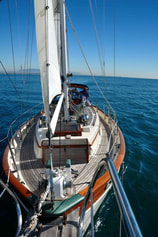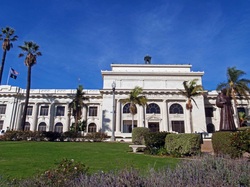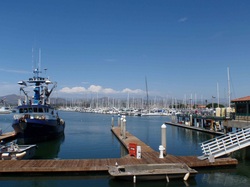Where Are We Now?

June 3, 2018
Ventura, California
Has it really been five years since we arrived in Ventura and completed our Circumnavigation? It may sound horribly cliché to say time flies … but, in this case, it is absolutely true. I guess the fact this is such an excellent place to live aboard and cruise has a lot to do with it.
Where to start?
Let’s start with the Eastern Santa Barbara Channel. Protected by the Channel Islands and tucked in the lee of Point Conception, the sailing conditions are generally excellent all year long. The climate is mild; the brief winters bring some rain and cooler temperatures – no snow or icy conditions to contend with – and steady breeze and sunny skies the rest of the year.
So, now Horizon is ready to embark on her next adventure.
What really makes this coastline special are the Channel Islands themselves. During the last ice age, Anacapa, Santa Cruz, Santa Rosa and San Miguel Island were together as one island, and were only 5 miles from the mainland. Today, the nearest anchorage on Santa Cruz, Smugglers, is only 18 miles from the Ventura Harbor entrance.
These are undeveloped islands; there are no moorings, no residential or commercial buildings (aside from the National Park Service buildings) and no artificial light. This is truly a place where one can spend days at a time comfortably at anchor, separated from the throng of Southern California.
But, before we could get out and really explore these islands, we first needed to get Horizon back to her pre-circumnav glory. A little incident that took place our last night out helped us determine where to start. It’s midnight and we had just passed Point Conception to our port; lights from Gaviota were the first we’d seen since leaving Honolulu. We were sailing downwind with a chunky 2-3 meter wrap-around following swell as we jybed back and forth to avoid the shipping lane. A boom fitting snapped – mid-jybe – and our boom swung out hard onto the intermediate shroud. We quickly wrapped some spectra line around the boom upon which to hang our main sheet blocks, and continued sailing to our destination. When we reached Ventura the next morning, we saw where the impact from the boom un-laid the wires of the intermediate shroud as it met the swage beneath the spreader. We had a birdcage and would not trust it under sail.
We had previously worked with Pacific Offshore Rigging down in San Diego so we knew where to get the replacement rigging … we simply had the matter of the 185 miles between us to contend with. No problem – after researching and deciding upon the replacement wiring and fittings, we began by carefully marking the existing rigging; sending Joseph up the mast to disconnect the top of the intermediate shrouds and coil them up for transport. If you leave early enough, the southbound drive through Los Angeles to San Diego can be done in just over 3 hours. Of course, once we dropped off the rigging, we’d have to visit some of our favorite culinary haunts (Jalisco’s in Imperial Beach was our favorite), and then make the trek home. A week later, we would return for the new rigging; deliver another piece and so on – seven times over.
Our relatively new head sail (built in Grenada just five months earlier) was already damaged by the foils of our roller furling unit. Tens of thousands of miles, rolling in and out countless times and constant vibration had worn the bushings to the point the edges of the foil sections were chewing holes in the bolt-rope. The rest of the sail was in great shape so we made the decision to replace the damaged edge of the sail with hanks and a sail bag. The furling unit came off the boat and we’ve not missed it. We created an easy “down-haul” system to quickly dowse the headsail without undue difficulties.
Our brightwork really took a beating since we were last able to give it proper attention during our time in the Philippines. It’s so much easier when you have access to power tools and finger piers – and perfect weather for varnish. We were able to get down to the bare wood and all of the surfaces properly coated just before the rains of our first winter arrived.
Horizon’s interior didn’t need much attention, but her cushions were definitely tired. We made a departure from color of the original forest green cushions and went with Sunbrella’s “Linen Sesame” fabric. It’s been a great choice – easy care and much more practical than earlier fabrics.
Our refrigeration unit gave us 15 years of stellar service but gradually gave out. We dropped a Norcold compressor with a smaller footprint beneath our port settee with new freezer box.
We shined up our Monitor windvane and took it off the stern pulpit, as well as our two 75-watt solar panels, and obtained a new teak pulpit grate upon which to install our 17 pound stainless steel Bruce stern hook with a shot of stainless chain and anchor rode. So now Horizon is ready to embark on her next adventure.
The question is - who will be at the helm?
Ventura, California
Has it really been five years since we arrived in Ventura and completed our Circumnavigation? It may sound horribly cliché to say time flies … but, in this case, it is absolutely true. I guess the fact this is such an excellent place to live aboard and cruise has a lot to do with it.
Where to start?
Let’s start with the Eastern Santa Barbara Channel. Protected by the Channel Islands and tucked in the lee of Point Conception, the sailing conditions are generally excellent all year long. The climate is mild; the brief winters bring some rain and cooler temperatures – no snow or icy conditions to contend with – and steady breeze and sunny skies the rest of the year.
So, now Horizon is ready to embark on her next adventure.
What really makes this coastline special are the Channel Islands themselves. During the last ice age, Anacapa, Santa Cruz, Santa Rosa and San Miguel Island were together as one island, and were only 5 miles from the mainland. Today, the nearest anchorage on Santa Cruz, Smugglers, is only 18 miles from the Ventura Harbor entrance.
These are undeveloped islands; there are no moorings, no residential or commercial buildings (aside from the National Park Service buildings) and no artificial light. This is truly a place where one can spend days at a time comfortably at anchor, separated from the throng of Southern California.
But, before we could get out and really explore these islands, we first needed to get Horizon back to her pre-circumnav glory. A little incident that took place our last night out helped us determine where to start. It’s midnight and we had just passed Point Conception to our port; lights from Gaviota were the first we’d seen since leaving Honolulu. We were sailing downwind with a chunky 2-3 meter wrap-around following swell as we jybed back and forth to avoid the shipping lane. A boom fitting snapped – mid-jybe – and our boom swung out hard onto the intermediate shroud. We quickly wrapped some spectra line around the boom upon which to hang our main sheet blocks, and continued sailing to our destination. When we reached Ventura the next morning, we saw where the impact from the boom un-laid the wires of the intermediate shroud as it met the swage beneath the spreader. We had a birdcage and would not trust it under sail.
We had previously worked with Pacific Offshore Rigging down in San Diego so we knew where to get the replacement rigging … we simply had the matter of the 185 miles between us to contend with. No problem – after researching and deciding upon the replacement wiring and fittings, we began by carefully marking the existing rigging; sending Joseph up the mast to disconnect the top of the intermediate shrouds and coil them up for transport. If you leave early enough, the southbound drive through Los Angeles to San Diego can be done in just over 3 hours. Of course, once we dropped off the rigging, we’d have to visit some of our favorite culinary haunts (Jalisco’s in Imperial Beach was our favorite), and then make the trek home. A week later, we would return for the new rigging; deliver another piece and so on – seven times over.
Our relatively new head sail (built in Grenada just five months earlier) was already damaged by the foils of our roller furling unit. Tens of thousands of miles, rolling in and out countless times and constant vibration had worn the bushings to the point the edges of the foil sections were chewing holes in the bolt-rope. The rest of the sail was in great shape so we made the decision to replace the damaged edge of the sail with hanks and a sail bag. The furling unit came off the boat and we’ve not missed it. We created an easy “down-haul” system to quickly dowse the headsail without undue difficulties.
Our brightwork really took a beating since we were last able to give it proper attention during our time in the Philippines. It’s so much easier when you have access to power tools and finger piers – and perfect weather for varnish. We were able to get down to the bare wood and all of the surfaces properly coated just before the rains of our first winter arrived.
Horizon’s interior didn’t need much attention, but her cushions were definitely tired. We made a departure from color of the original forest green cushions and went with Sunbrella’s “Linen Sesame” fabric. It’s been a great choice – easy care and much more practical than earlier fabrics.
Our refrigeration unit gave us 15 years of stellar service but gradually gave out. We dropped a Norcold compressor with a smaller footprint beneath our port settee with new freezer box.
We shined up our Monitor windvane and took it off the stern pulpit, as well as our two 75-watt solar panels, and obtained a new teak pulpit grate upon which to install our 17 pound stainless steel Bruce stern hook with a shot of stainless chain and anchor rode. So now Horizon is ready to embark on her next adventure.
The question is - who will be at the helm?

City Hall and statue of Father Serra
December 8, 2012
Ventura Harbor, Ventura, California
The city of Ventura initially began as Mission San Buenaventura by the Franciscan Friar Junipero Serra in 1782 and he named it after a thirteenth century Franciscan saint, St. Bonaventure. The area was previously home to the Mitskanaka band of Chumash Native North Americans. The city is located between the Ventura and Santa Clara rivers and the fertile soil and mild climate lured citrus growers to the area. But it wasn’t until completion of Highway 101 in 1959 that connected the communities of Ventura, Oxnard and Camarillo to the greater Los Angeles metro area that the population increased.
It’s hard to believe we’ve been back over three months already. We’ve been incredibly busy getting “Horizon” out of voyaging mode and back into dock mode. First order of business was getting all of our parts and spares off the boat and it helps having an excellent storage facility nearby. The 20,000 miles we’ve put under our keel since the Philippines were most visible on “Horizon’s” brightwork, the bulwarks looked particularly tired. Ventura’s fabulous weather has given us a chance to scrape off all the old stuff, sand the wood to a smooth finish and apply all of the necessary coats to make our girl shine once again. Plenty of photos in the After the Circumnavigation folder.
Ventura Harbor, Ventura, California
The city of Ventura initially began as Mission San Buenaventura by the Franciscan Friar Junipero Serra in 1782 and he named it after a thirteenth century Franciscan saint, St. Bonaventure. The area was previously home to the Mitskanaka band of Chumash Native North Americans. The city is located between the Ventura and Santa Clara rivers and the fertile soil and mild climate lured citrus growers to the area. But it wasn’t until completion of Highway 101 in 1959 that connected the communities of Ventura, Oxnard and Camarillo to the greater Los Angeles metro area that the population increased.
It’s hard to believe we’ve been back over three months already. We’ve been incredibly busy getting “Horizon” out of voyaging mode and back into dock mode. First order of business was getting all of our parts and spares off the boat and it helps having an excellent storage facility nearby. The 20,000 miles we’ve put under our keel since the Philippines were most visible on “Horizon’s” brightwork, the bulwarks looked particularly tired. Ventura’s fabulous weather has given us a chance to scrape off all the old stuff, sand the wood to a smooth finish and apply all of the necessary coats to make our girl shine once again. Plenty of photos in the After the Circumnavigation folder.
1

Ventura Harbor on a lovely summer day
August 29, 2012 – December 7, 2012
Ventura Harbor, Ventura, California
Despite having traveled 70,000 n.m. over the past ten years, we’ve always called San Diego “home,” and it is “Horizon’s” hailing port. The Channel Islands, also known as the “California Galapagos” have long been a favorite cruising ground for us, but are situated too far from San Diego to be easily accessible. We visited Ventura in 2003 when we sailed from Sitka, Alaska bound for San Diego, and came away with a very positive impression of the community. Its close proximity to the Channel Islands tipped the scales and we decided to make our new home here. The weather has been excellent, our new neighbors are friendly and helpful, and we are looking forward to a road-trip to visit friends and family in the coming weeks.
Ventura Harbor, Ventura, California
Despite having traveled 70,000 n.m. over the past ten years, we’ve always called San Diego “home,” and it is “Horizon’s” hailing port. The Channel Islands, also known as the “California Galapagos” have long been a favorite cruising ground for us, but are situated too far from San Diego to be easily accessible. We visited Ventura in 2003 when we sailed from Sitka, Alaska bound for San Diego, and came away with a very positive impression of the community. Its close proximity to the Channel Islands tipped the scales and we decided to make our new home here. The weather has been excellent, our new neighbors are friendly and helpful, and we are looking forward to a road-trip to visit friends and family in the coming weeks.